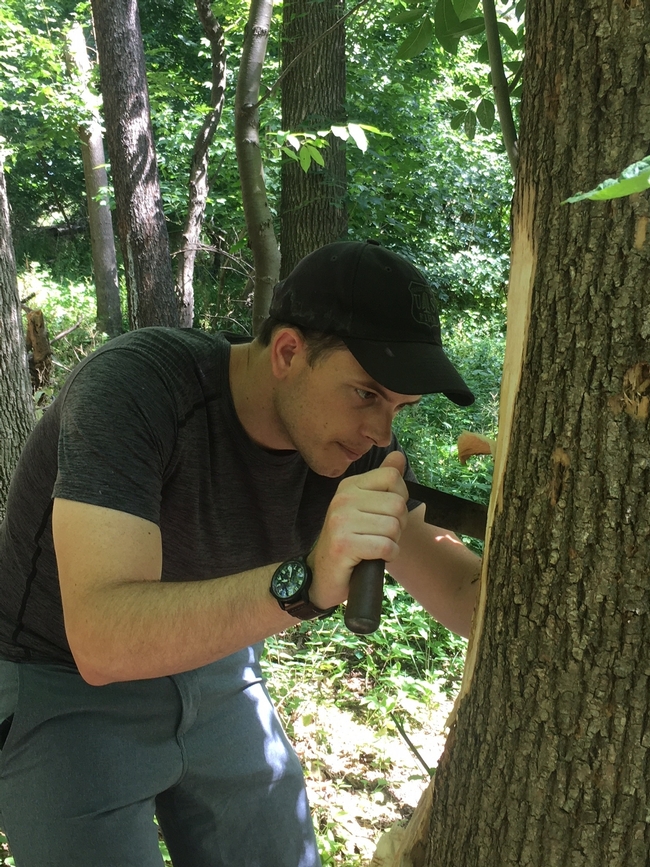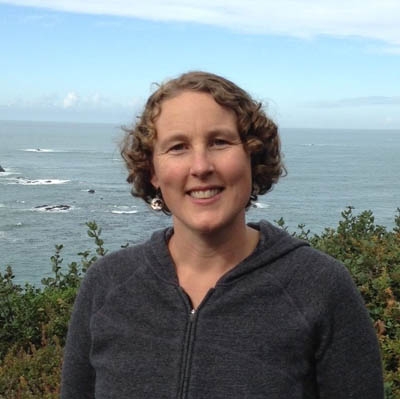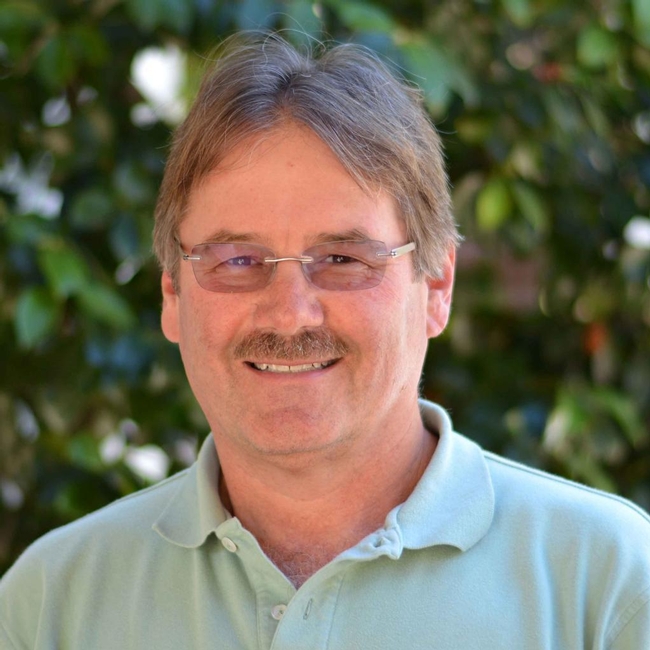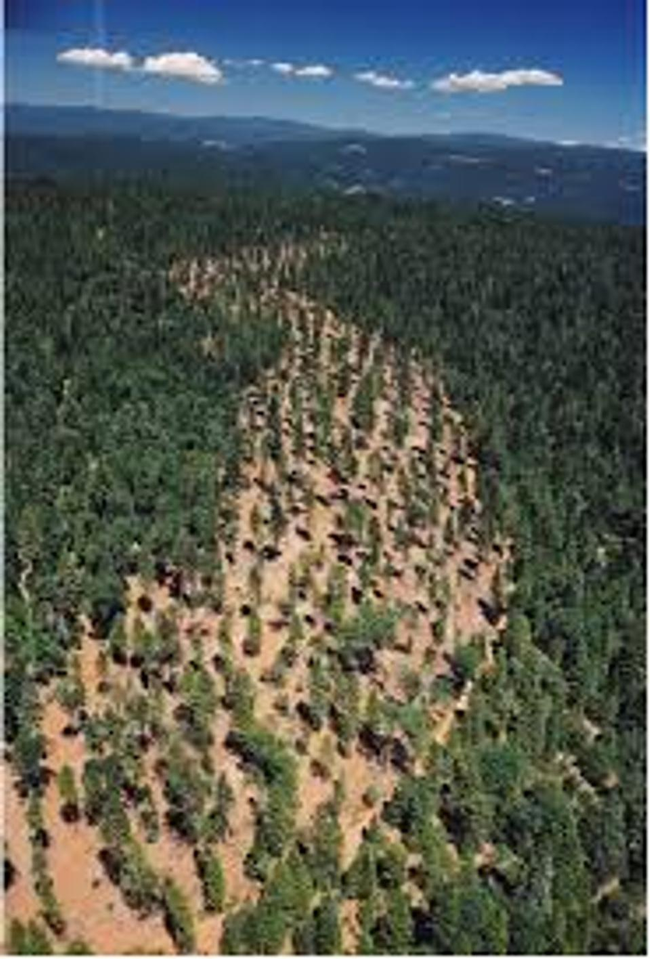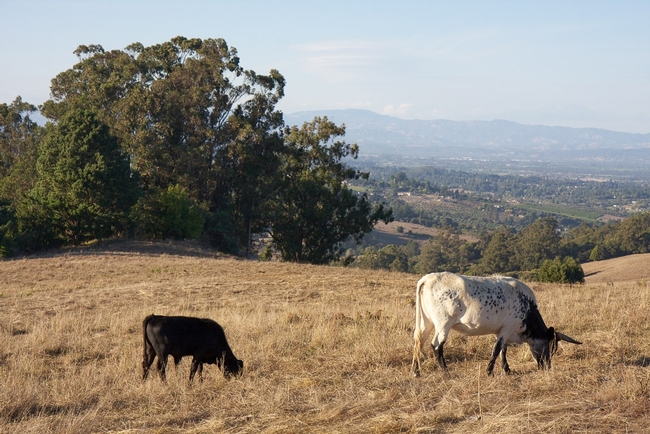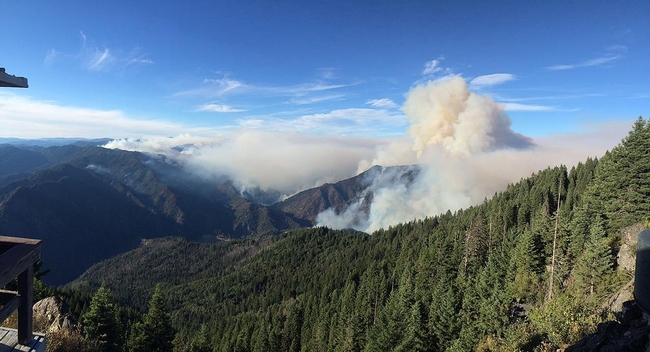Food & Health
California must become a fire-adapted civilization, UCCE expert says
The vast California acreage burned in 2020 and the protracted smoky skies should signal state residents and officials to adapt to a new reality, reported Ezra David Romero on Capital Public Radio. The 4 million acres of wildland burned this year isn't unprecedented.
Before 1800, 4.5 million or more burned every year in California, according to a UC Berkeley study.
Tragic as they are, parts of the 2020 fires will bring some areas back to natural equilibrium.
"Some areas are going to be hit really hard . . . and will have trouble recovering," said Michael Jones, UCCE forestry advisor in Lake County. "But other areas will look phenomenal. They'll look fantastic and they'll do exactly what we want these systems to do."
However, the burns are unprecedented in California's modern, highly populated times.
“I don't think that we can have another season like this without something fundamentally shifting,” he said “This is another indication of how we need to think differently about how we approach managing fire, and how we need to become more of a fire-adapted civilization."
It may be "a tough pill to swallow," but Jones told Romero that smoky skies could become a year-long reality because of prescribed burns in cooler months and a prolonged wildfire season in the warmer months.
“People are exhausted,” Jones said, “they're scared and don't understand this fundamental shift and change.”
Jones says the current fire season should also force people to rethink where communities should be built.
North Coast forests are more dense and dry, fueling fires
Five of California's six largest fires have occurred in 2020, reported Julie Cart in CalMatters.
“There is a collective sensation that we are reaching a tipping point,” said Lenya Quinn-Davidson, a fire specialist with the University of California Cooperative Extension. “This year was not just the fluke burning horrifically. This is 3.2 million acres of fire that burned in a month.”
Quinn-Davidson is based in Humboldt County, with typically rainy, foggy redwood forests. However, she said, the forests don't resemble their former state.
"They are suffering from the same things that the rest of the state forests are. They are poorly managed and have fuels buildup," Quinn-Davidson said.
Redwood and pine forests are many times more dense than at any time in their history.
"We are now entering a new regime, the climate is changing and we are seeing drier conditions and we are seeing a longer fire season. We are not getting that fall precipitation," she said.
The state's 2018 Fourth Climate Assessment included dire predictions for the North Coast: “Future wildfire projections suggest a longer fire season, an increase in wildfire frequency, and an expansion of the area susceptible to fire.”
Average annual maximum temperatures in Mendocino, Humboldt, Del Norte, Lake, Trinity and Siskiyou Counties could increase by as much as 9 degrees through the end of the century, the report concluded.
“The weather and climate is impacting these areas. Last year we were at 60% of average precipitation. We're drier than normal,” said Scott Stephens, a fire scientist at UC Berkeley. “So when lighting strikes, you get an overwhelming number of ignitions in fuels that have been preconditioned to burn.”
The fog that reliably blankets the North Coast is dissipating. Research from UC Berkeley found that fog frequency has declined by a third compared with a century ago.
“Even here in Humboldt County — we are right on the ocean, basically in a rainforest — people are starting to look around and say, ‘Is my house ready for a wildfire?' I'm hearing those conversations,” Quinn-Davidson said.
UC ANR experts suggest ways to ease California's fire crisis
Three news articles over the last weekend shared comments from UC Agriculture and Natural Resource's experts about forest management practices that can help reduced the catastrophic wildfires being experiences in the West.
Prescribed burns and management change fire behavior
Shaver Lake forest historian Jared Dahl Aldern tweeted that, when the high-intensity Creek Fire arrived at the Shaver Lake forestlands, it turned into a low-intensity “surface fire,” which does not threaten the bigger and older trees. “The fire comes up to @SCE land,” tweeted Aldern, “drops to the ground, and stays out of the tree crowns.”
Whatever happens to Shaver Lake, says University of California Cooperative Extension specialist Rob York, “There are lots of cases in the scientific literature of prescribed burns having changed fire behavior.”
The image below shows a “shaded fuel break,” consisting of selectively-thinned forest surrounded on both sides by dense forest. “The strip of forest may change fire behavior in the treated area,” said York, “but not on either side.
Forbes, Sept. 13, 2010
Michael Shellenberger
Millions of dead trees fueling unprecedented firestorms in the Sierra Nevada
“I don't want to be alarmist. But I think the conditions are there,” said Scott Stephens, a UC Berkeley professor of fire science and lead author of a 2018 paper that raised the specter of future mass forest fires as intense as the Dresden, Germany, and Tokyo firebombings.
“As those [trees] continue to fall, the physics of it are unchanged. If you have dead and downed logs … the fires described in warfare are possible.”
A combination of prescribed fire, restoration thinning and making rural communities more fire resistant are needed, Stephens said.
“If we don't come out of this year focused on that and try to move forward, I just don't know if there's much hope,” he said. “I'm always hopeful. But I'm getting tired.”
Los Angeles Times, Sept. 13, 2020
Bettina Boxall
Results of long-time fire suppression
Perhaps the most present term in news articles as one of the main causes for fires getting so big so fast is fire suppression, which has resulted in a lack of fire for more than a century.
In the 1920s, this idea of suppressing wildfires grew even more when the Forest Service decided intentional burning was a bad idea. In 1924 a Siskiyou National Forest Supervisor said the ‘“Brushy Hell' of shrublands must be protected for the benefit of future timberland succession, ‘so leave them alone.'”
“The Forest Service said it ruins forests, it was bad forest management,” said Kocher. “Then in 1924, California followed suit and said it was not legal to burn forests on purpose.”
Kocher says this idea of letting trees grow and not letting forests burn naturally every decade wasn't this malicious idea either.
“They would have thought, ‘Oh, we're doing this great work where we're leaving all these extra trees for people to use for timber moving forward,'” she said. “I don't think those early foresters ever could have foreseen how fire could get away from them.”
Capitol Public Radio, Sept. 12, 2020
Ezra David Romero
Cattle grazing is a tool for reducing fire danger
Cattle can help reduce wildfire danger by grazing on fine fuels in rangeland and forest landscapes, reported Sierra Dawn McClain in Capital Press. The article also appeared in the Blue Mountain Eagle, the Westerner and the East Oregonian.
The article cited the preliminary results of research by UC Cooperative Extension that show that cattle consumed approximately 12.4 billion pounds of forage across California in 2017. The researchers believe the cattle could do more.
Many grazable acres aren't grazed, said Sheila Barry, UCCE livestock and natural resources advisor in Santa Clara, San Mateo, Alameda and Contra Costa counties. According to the Capital Press article, Barry said the public doesn't always recognize the benefits of grazing; they see short grass and cow patties. Cattle's role in preventing wildfires is often overlooked.
Devii Rao, UCCE livestock and natural resources advisor for San Benito, Monterey and Santa Cruz counties and the study's lead, said ranchers should target grazing around homes, infrastructure, roadsides and at the wildland-urban interface.
“There are so many things we can do better. Cattle grazing is really important to fire safety, and it's time we have more conversations about it,” Rao said.
UCCE experts provide scientific fire information to media
The raging fires sparked during August have raised the visibility of UC fire scientists, who provide critical information to state and national media. Below are a sampling of stories and comments offered by UC Cooperative Extension experts:
Forest management needed
“When we started suppressing fires 100 years ago all the time, we actually allowed a huge buildup of fuels and debris,” said UC Cooperative Extension forest advisor Susie Kocher, who is based in the Lake Tahoe region.
She is an advocate for requiring residents to clean up the extra fuel — grasses, trees, shrubs and clutter — around their homes, making them fire ready, and for more prescribed burns.
“There's a need for more frequent, low-severity fire across the landscape, so that we wouldn't have quite so much explosion in the burning in the fields that we have currently,” Kocher said.
In August, the state and federal government agreed to clean up 1 million acres by 2025, with practices such as prescribed burns. Part of that agreement also included a commitment to create a 20-year plan by next year to prioritize areas for forest-thinning. But even this plan is sliver of what's needed to protect California from devastating future wildfires.
“I think it's a good indication they're paying attention now and that we're moving in the right direction,” said Michael Jones a UC Cooperative Extension forestry advisor in Mendocino, Lake and Sonoma counties. “My hope is that once we start with a million, then it's really easy to scale up to multiple millions.”
Capitol Public Radio, Sept. 3, 2020Taking steps to reduce fire danger
“There are things that we can and should be doing to address the fire problem and fire risk in California, and to get ahead of it, and to make ourselves more resilient,” said Lenya Quinn-Davidson, a fire advisor with the University of California Cooperative Extension and director of the Northern California Prescribed Fire Council.
Quinn-Davidson said she was encouraged when California Gov. Gavin Newsom and U.S. Forest Service officials announced an agreement this month on a joint strategy to reduce wildfire risks.
“We need more coordination and more collaboration among all of the different groups who work on these issues,” Quinn-Davidson said. “The number one thing we need is more coordinated vision around what fire is going to look like in California, how people can live with fire.”
Arizona Central, Aug. 28, 2020
What's at stake
“Every part of California is receptive to wildfire,” said Yana Valachovic, a UC Cooperative Extension forestry advisor on the North Coast. “Especially in a year like this, when we had a pretty dry winter and spring, so a lot of the state is in drought conditions.”
Sacramento Bee, Aug. 27, 2020
Fires are getting worse
"They are certainly getting worse over time," said Susan Kocher, a forestry advisor at the University of California-Cooperative Extension Central Sierra. "We burned fewer acres in wildfires in 2019 than 2018, but overall, yes, the trend is progressing to burning more and more acres at high severity over time and affecting more people through evacuations and damages to homes and communities."
Yana Valachovic, a forest advisor and county director at University of California Cooperative Extension–Humboldt and Del Norte counties, said that 100 years of fire suppression is catching up to the state as well. Valachovic said before California was settled by white pioneers around the gold rush in the 1850s, Native Americans frequently used fire as a tool —for example, to clean out an infestation of bugs in acorns.
"Fire can be really important for stimulating biodiversity and creating more food sources," Valachovic said. "After years of suppressing those fires, now we get an ignition, whether human-caused or lightning-caused or power lines down, and you have an accumulation of materials that have accumulated over various time periods, but the quantity of fuel is substantially greater than it was historically."
Salon, Aug. 25
Firefighting priorities
“At the statewide level, we do get into this mode where we start wondering where the biggest loss is going to be, what's the highest priority, and that is where the resources are going to go,” said Lenya Quinn-Davidson, a fire specialist with the UC Cooperative Extension.
Los Angeles Times, Aug. 24, 2020
Take action
Q: Beyond widely accepted reasons for wildfires growing in size, severity, and frequency, why hasn't California made more progress in slowing the trend?
Lenya Quinn-Davidson: Our fire management and our land management haven't kept pace with the scientific understanding we have of fire in California. There's this fear of active land management – prescribed burning, thinning – that sometimes gets in the way of us making good choices. If we're not protecting the resources we care about and we're not taking action, then we will continue to lose them to big fires.
Bill Stewart: Many of the fires around the greater Bay Area are in areas that didn't burn 30 years ago because they were cattle ranches. They had cattle on them, and that helped reduce fuels. Now those areas have turned into parks or 5- and 10-acre residential lots. So much development has been about what's aesthetically pleasing, so we've ended up with a landscape that, during hot and dry seasons, there's a lot more fuel and it becomes a much riskier situation.
Q: The era of megafires in California has been decades in the making. How can public agencies begin to counter that over the next few years?
Quinn-Davidson: We need to create a more robust and sustainable fire workforce. Right now, they're so beat down at the end of fire season – especially as fire season is getting longer in California – that there's basically no capacity the rest of the year to do any of the proactive stuff we need to be doing. So we need to create more jobs, and those jobs need to be dedicated to fire management and land management.
Christian Science Monitor, Aug. 24, 2020
Historical fire suppression
“We have put out fires for 100 years. Now we are paying the price,” said Scott Stephens, a professor of fire science at UC Berkeley. “It will take a while to make these forests healthy again. But it's absolutely possible.”
Stephens, the UC fire scientist, estimates that before the Gold Rush, roughly 4.5 million acres a year in California burned. By the 1950s and 1960s, that was down to about 250,000 acres a year. In recent years, it has approached 2 million acres a year.
San Jose Mercury News, Aug 23, 2020
Limited firefighting resources
At the statewide level, we do get into this mode where we start wondering where the biggest loss is going to be, what's the highest priority, and that is where the resources are going to go,” said Lenya Quinn-Davidson, a fire expert with the University of California Cooperative Extension.
Los Angeles Times, Aug. 22, 2020
Smoke impact on fresh produce
According to a 2018 preliminary UC Cooperative Extension Sonoma study, smoke from 2017 fires had little impact on local Sonoma County produce.
Based on preliminary findings, "...produce safety was not significantly affected by the fires and may be mitigated by washing produce."
The Californian, August 21, 2020

